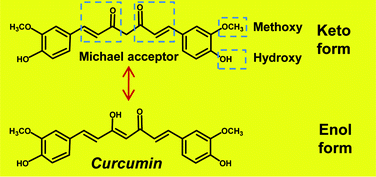Multitargeting by curcumin as revealed by molecular interaction studies
Abstract
Covering: up to early 2011

* Corresponding authors
a
Cytokine Research Laboratory, Department of Experimental Therapeutics, The University of Texas MD Anderson Cancer Center, Houston, Texas
E-mail:
aggarwal@mdanderson.org
Fax: +713-745-6339
Tel: +713-794-1817
b Department of Chemistry and Biochemistry, The University of Texas at Austin, Austin, Texas
c Radiation and Photochemistry Division, Bhabha Atomic Research Centre, Mumbai, India
Covering: up to early 2011

 Please wait while we load your content...
Something went wrong. Try again?
Please wait while we load your content...
Something went wrong. Try again?
S. C. Gupta, S. Prasad, J. H. Kim, S. Patchva, L. J. Webb, I. K. Priyadarsini and B. B. Aggarwal, Nat. Prod. Rep., 2011, 28, 1937 DOI: 10.1039/C1NP00051A
To request permission to reproduce material from this article, please go to the Copyright Clearance Center request page.
If you are an author contributing to an RSC publication, you do not need to request permission provided correct acknowledgement is given.
If you are the author of this article, you do not need to request permission to reproduce figures and diagrams provided correct acknowledgement is given. If you want to reproduce the whole article in a third-party publication (excluding your thesis/dissertation for which permission is not required) please go to the Copyright Clearance Center request page.
Read more about how to correctly acknowledge RSC content.
 Fetching data from CrossRef.
Fetching data from CrossRef.
This may take some time to load.
Loading related content
